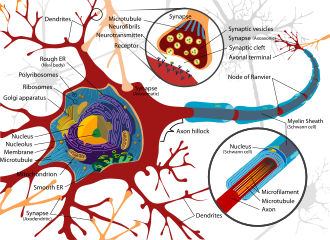Neural tissue
Neural tissue integrates signals regarding all body activities and maintains them within physiologically acceptable limits. It accomplishes this by
- sensing changes in the environment via sensory receptors
- interpreting, integrating and storing those changes in memory
- responding to environmental changes via effectors
The two primary cell types are neurons and neuroglia.
Anatomically, neural tissue is divided into the central nervous system (brain and spinal cord) and the peripheral nervous system (nerves and ganglia).
Neuronal structure[edit | edit source]
The nerve cell consists of the body (soma, perikaryon) and two types of protrusions, afferent dendrites and efferent neurites ( axons ).
- Soma (aka perikaryon)
- body of the neuron bounded by plasma membrane
- determines origin and spread of excitement
- contents:
- nucleus
- large
- much protein synthesis necessary, so DNA is in euchromatin form
- nucleolus often visible
- Nissl substance (accumulations of RER) - schematic of position
- mitochondria
- lipofuscin pigment aggregations
- cytoskeleton
- actin, neurotubules (eq. of microtubules), and neurofilaments (eq. of intermediate filaments)
- functions in axonal transport (repair axolemma, transport proteins such as gated ion channels, enzymes, neurotransmitters)
- Slow transport: 1-5 mm/day
- Fast transport: 200-400 mm/day
- nucleus
- Neuronal processes
- Dendrites
- receive afferent signals
- typically short and richly branched
- terminally branch as dendritic spines, where presynaptic axons synapse
- Axon (aka neurite)
- only one per perikaryon
- up to 1 m long and 15 μm thick
- originate at the axon hillock
- axolemma (equivalent of plasma membrane) encloses axoplasm
- transmits the action potential from the body of a neuron to another neuron or effector
- contents:
- ribosomes
- small amounts of mitochondria
- myelinated axons: myelin sheath covers the entire length of the axon except at the start, at the terminal branches, and at nodes of Ranvier. Faster conduction.
- unmyelinated axons:
- Dendrites
- Neuropil: material that fills the space between the perikarya and glial cells, together with the ECM
Types of neurons[edit | edit source]
There are several ways by which neurons may be classified:
- Morphological (number of processes):
- multipolar
- most common
- bipolar
- sensory neurons: retina, vestibular and cochlear ganglia
- unipolar
- unipolar brush cell in cerebellum
- pseudounipolar
- sensory ganglia of cranial nerves, spinal ganglia
- multipolar
- By axon length:
- Golgi type I - neurons with long neurite;
- Golgi type II - neurons with short neurite.
- Position and Functional in the Neuronal Network:
- Motor (efferent): stimulate muscles, glands, and other neurons
- Sensory (afferent): receive stimuli
- Interneurons: local circuit neurons
- Type of neurotransmitter
- Excitatory: Amino acids, monoamines, catecholamines
- Inhibitory: GABA, Serotonin
- Both: Dopamine
Synapses[edit | edit source]
Synapses are specialized cell junctions that link neurons in a pathway. A single neuron may have 1-10 thousand synapses.
The signal can be transmitted via axodendritic, axosomatic or axoaxonic connections.
- electrical synapses: transmit signal via gap junctions
- chemical synapses:
- synaptic vesicles (30-60 nm) from the presynaptic axon terminal merge with the presynaptic membrane and release contents into the synaptic cleft (20-30 nm)
- postsynaptic membrane contains receptors for neurotransmitters
- asymmetric synapses
- excitatory
- thick post-synaptic membrane
- 30 nm synaptic cleft
- depolarize membrane of postsynaptic neuron via Na+
- symmetric synapses
- inhibitory
- thin post-synaptic membrane
- 20 nm synaptic cleft
- hyperpolarize membrane of postsynaptic neuron via Cl-
Central and peripheral nerve endings[edit | edit source]
In the CNS, neurons synapse with other neurons.
In the PNS, they can synapse and neuromuscular or neuroglandular junctions.
See schematic.
References[edit | edit source]
Mescher, A. and Junqueira, L., 2018. Junqueira's basic histology. New York: McGraw-Hill, pp. 161-191.
Vaňhara, Petr et al. Guide To General Histology And Microscopic Anatomy. 1st ed., Masaryk University Press, 2020, pp. 6.






